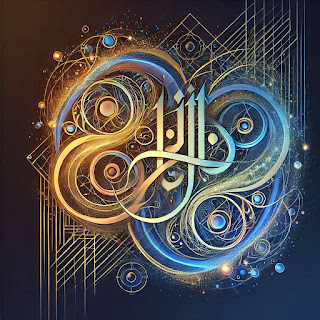The Universal Connection of Sacred Geometry and Arabic Calligraphy
786
بِسْمِ اللَّهِ الرَّحْمَٰنِ الرَّحِيمِ,
Bismillah Hir Rahman Nir Rahim,
With the name of Allah, the Most Merciful, Most Compassionate.
Exploring how Arabic calligraphy, rooted in sacred geometry, bridges universal consciousness and personal transformation.Exploring a Blueprint of Creation
Sacred geometry has long been considered a blueprint for creation, offering a glimpse into the divine order that underlies the universe. Its patterns, found in everything from the spiral of galaxies to the structure of DNA, suggest a universal language that transcends culture and time. But what if this concept extends beyond geometry, linking to human-created systems such as writing?
Arabic calligraphy, with its deep roots in geometric principles and spiritual significance, may hold the potential to serve as a bridge between the individual and universal consciousness. Through its design and its connection to the divine, Arabic script might unite us not just on a physical level but across the energetic, psychological, and even cosmic planes.
Sacred Geometry as the Foundation of Creation
The foundational principles of sacred geometry are simple yet profound: shapes like the circle, square, and triangle form the basis for structures in nature, art, and architecture. These patterns are not arbitrary; they represent the inherent harmony of the universe, a system that reflects balance and proportion on every level.
In spiritual traditions, sacred geometry has often been viewed as a tool for meditation and enlightenment. By aligning with these geometric patterns, individuals can experience a deeper connection to the cosmos, understanding themselves as part of a larger, unified whole.
Arabic Calligraphy: A Geometric and Spiritual Art Form
Arabic calligraphy, more than just a method of writing, is deeply rooted in sacred geometry. The creation of each letter and word involves careful attention to proportion and balance, often guided by geometric grids. Styles like Kufic, for instance, emphasize symmetry and structure, making the script as much an art form as a communication tool.
What sets Arabic calligraphy apart is its spiritual dimension. The script is often used to transcribe the Quran, Islam’s holy book, and its rhythmic curves and elegant forms are designed to inspire reverence and contemplation. By combining the aesthetic principles of sacred geometry with the spiritual power of divine words, Arabic calligraphy transcends ordinary writing to become a means of connecting with the divine.
The Connection to Consciousness
Jungian psychology introduces the idea of a collective unconscious, a shared reservoir of symbols and archetypes that resonate across humanity. Sacred geometry is one such archetype, a set of patterns that evoke a sense of harmony and unity regardless of cultural background.
Arabic calligraphy, with its fusion of geometric precision and spiritual meaning, may similarly tap into this collective unconscious. Its forms and sounds, rooted in sacred tradition, have the potential to evoke a deep connection to universal truths.
When we observe or create Arabic calligraphy, we engage with these archetypes on multiple levels:
- Visual Resonance: The script’s geometric elegance mirrors the patterns found in nature and sacred geometry.
- Aural Power: The recitation of Arabic words creates sound vibrations that can influence the mind and body.
- Kinesthetic Engagement: Writing Arabic involves precision and flow, fostering a meditative state that aligns the individual with higher consciousness.
Healing and Harmony: Mind, Body, and Spirit
Engaging with Arabic calligraphy—whether through observation, recitation, or practice—may harmonize the individual on several levels:
- Energy Alignment: Sacred geometry is believed to resonate with the body’s energy systems, and Arabic calligraphy, designed with geometric precision, may serve a similar role.
- Brain Connectivity: Writing in Arabic activates both hemispheres of the brain, strengthening neural pathways and promoting mental balance.
- Collective Connection: Just as sacred geometry represents the interconnectedness of all things, Arabic calligraphy’s universal appeal can foster a sense of shared humanity.
Bridging the Individual and the Universal
If sacred geometry serves as a visual and structural representation of universal consciousness, Arabic calligraphy may act as its dynamic counterpart. The combination of form, sound, and meaning inherent in Arabic script creates a unique medium for connecting with the divine and with one another.
The bold idea of Arabic calligraphy as a bridge to universal consciousness invites us to explore how art and sound can align our individual experiences with the greater patterns of existence. Could this sacred writing system, rooted in geometry, offer a pathway to unity—not just within ourselves but across humanity?
This exploration is more than an intellectual exercise; it’s an invitation to engage with the profound possibilities of sacred art. Through sacred geometry and Arabic calligraphy, we may uncover the timeless truths that connect us all.




Comments
Post a Comment